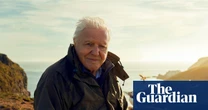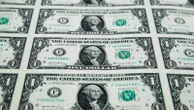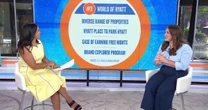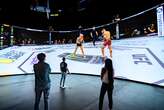In the opening vignette of a recent advertisement campaign by Liquid I.V., a woman weighed down by several hefty bags of groceries is struggling to walk up a steep hill in sweltering heat.
She pours a stick of electrolyte powder into her water bottle and is quickly propelled into the air. Hydration, it turns out, is pretty powerful.
“Heat-related dehydration is one of the most prevalent usage occasions that we focus on because it is truly universal,” says Stacey Andrade-Wells, VP of marketing at Liquid I.V., of the brand’s latest ad called “Tear. Pour. Live. More.”
Peak “hydration season” runs from May through September, and brands including Gatorade, BodyArmor, and DripDrop have joined Liquid I.V. in debuting new campaigns to generate buzz.
“This is our Super Bowl,” says Sabrina Niland, VP of innovation and strategy at BodyArmor. “The summer is the most important time of the year for our business.”
PepsiCo’s Gatorade remains dominant with two-thirds of the market and still primarily focuses on athletic endeavors. But newer entrants have broadened the “occasions” for functional beverages and powders, telling consumers that hydration is just as important when temperatures spike, during travel or while at a music festival, and for recovery after a long night out partying.
Long gone are the days when sports drinks were only marketed by athletic superstars like Michael Jordan, though he’s back too in a new Gatorade spot. The latest crop of hydration influencers include singers Carrie Underwood and Anitta, actor Michael B. Jordan, and Peloton instructor Kirsten Ferguson.
“The beverage companies are getting better and better at looking at their portfolios across the day,” says Duane Stanford, editor and publisher of Beverage Digest. Because beverage consumption trends are relatively stable, Stanford says, “Everyone is fighting for those eight drinks. They can only drink so much liquid.”
Beverage Digest reports that dollar sales for sports drinks increased 7.6% in 2023 from the prior year for multi-channel locations, including supermarkets, convenience stores, and drug chains. However, volume declined 4.3%, aligning with the broad decline at grocery stores last year as high inflation stung shoppers.
Innovations fueling growth for the sports drink category include zero-sugar beverages, new flavors like cotton candy and watermelon, new formats like single-serve powder sticks, and rapid rehydration drinks like Gatorade Gatorlyte and Electrolit, an import from Mexico that’s made by a pharmaceutical company.
Hot weather also helps lift sales. The industry is benefiting from a particularly favorable weather tailwind, as June was the 13th consecutive monthly heat record on Earth. “To the extent that we do have hotter temperatures, that is good for the beverage industry,” says Stanford.
“Our strategy has been to elevate the categories we play in,” says Niland of BodyArmor’s strategy to disrupt the category beginning in 2011 by offering “cleaner” drinks without artificial sweeteners, flavors, or dyes. It is a popular playbook across the grocery store. Legacy brands fall out of favor with consumers, and new entrants come in promising better-for-you options that align with current nutritional preferences.
BodyArmor was acquired by Coca-Cola in 2021, giving the beverage giant a more premium offering than its own Powerade. But distracted by the dealmaking, BodyArmor needed to focus more on innovation. The company debuted new brand extensions, including BodyArmor Zero and the BodyArmor Flash I.V. rapid rehydration drinks and powder sticks to get back on track. Marketing for Flash I.V. has focused on battling heat or a hangover, with a particular demographic focus on the Hispanic consumer.
Many of the industry’s scientific claims focus on electrolytes, including minerals like potassium and calcium, which play a critical role in controlling the nervous system and keeping muscles functioning. However, the guidelines issued by the federal government focus on water consumption, not electrolytes. The most recent recommendation from the U.S. National Academies of Sciences, Engineering, and Medicine says around 15.5 cups of fluids per day is enough for a man and 11.5 cups for a woman. Both recommendations cover fluids from water and food, with around 80% coming from drinks.
DripDrop leans on those scientific claims, including that it has three times as many electrolytes versus the leading sports drink and works two times faster than water alone. Invented by Mayo-trained physician Dr. Eduardo Dolhun, DripDrop says it is in over 90% of the five major U.S. professional sports leagues. The U.S. military and first responders, including firefighters, also use it.
This year’s new campaign, “Gotta Have My Drip,” leaned on social media influencers. DripDrop has unveiled new flavors and expanded beyond its traditional strength in e-commerce channels to more physical stores like Walmart and Target.
“We’re more of an underdog brand right now,” says John Shea, chief marketing officer of DripDrop, who says his focus is on the more educated consumer who has determined faucet water and sports drinks just aren’t enough to quench their thirst. “They’re looking at the science and what they need to perform at their best.”
Alongside Jordan, Gatorade’s ad campaign features fresh faces, including WNBA stars A’Ja Wilson and Caitlin Clark, as the sports drink giant angles to inspire more Gen Z athletes to participate in sports after research has shown participation is down. “Our entire campaign focus is about reminding athletes that they have what’s inside to overcome and achieve their goals,” says Anuj Bhasin, Gatorade’s chief brand officer, of the generational shift in tone in the brand’s advertising focus.
Over the years, innovation has broadened to include new formats like pods and tablets and new platforms like Gatorade Zero, Gatorade Water, and Gatorlyte, the latter of which has been a solid seller lately.
Lindsay Baker, a principal scientist at the Gatorade Sports Science Institute, explains that sports science has evolved from one-size-fits-all thinking to a greater understanding of individual differences in hydration. Two athletes competing in the same sport and with the same body proportions may sweat very differently, and thus, the recommendations to rehydrate them would greatly vary. That applies to the general population as well.
“That’s been reflected a bit in our innovation, in the sense that we have a whole portfolio of products ranging from low, to mid, to higher amounts of carbohydrate and the same sort of a continuum in terms of electrolytes as well,” says Baker.
Liquid I.V. unveiled a brand refresh this spring to more clearly emphasize flavors and the functional benefits of the powder sticks. “What we were hearing was that consumers really didn’t understand the articulation of our science,” says Andrade-Wells. “They were looking for a bit more transparency on what the product does.”
Acquired by Unilever in 2020, Liquid I.V. has doubled the brand’s reach across U.S. stores to over 80,000 locations. It re-released a seasonal favorite, cotton candy, and quickly saw the new cherry, lemon-lime, and raspberry “firecracker” flavor sell out after generating buzz on TikTok.
“Consumers are becoming more aware of the role of hydration in their everyday life,” says Andrade-Wells. “Dehydration is something that is relevant year round.”










No comments